
Tetraodontiformes, also known as the Plectognathi, is an order of ray-finned fishes which includes the pufferfishes and related taxa. This order has been classified as a suborder of the order Perciformes, although recent studies have found that it, as the Tetraodontoidei, is a sister taxon to the anglerfish order Lophiiformes, called Lophiodei, and have placed both taxa within the Acanthuriformes. The Tetraodontiformes are represented by 10 extant families and at around 430 species overall. The majority of the species within this order are marine but a few may be found in freshwater. They are found throughout the world.
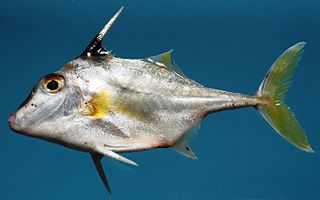
Triacanthidae, the triplespines or tripodfishes, is a family of marine ray-finned fishes belonging to the order Tetraodontiformes, whicj also includes the pufferfishes, boxfishes, filefishes and related groups. The family is made up of four extant genera and three extinct genera which are known from fossils.
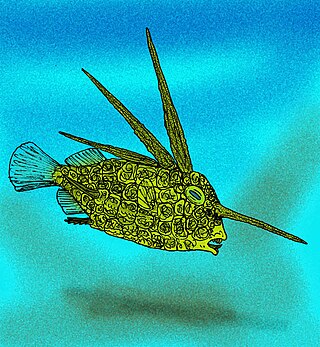
Eospinus daniltshenkoi is an extinct tetraodontid bony fish from the Eocene. Its fossils are from the Danata Formation lagerstatten of Ypresian Turkmenistan.

The spikefishes are ray-finned fishes related to the pufferfishes and triggerfishes. They live in deep waters; more than 50 m (160 ft), but above the continental shelves. They are found in the Atlantic, Indian Ocean, and the west-central Pacific.
Plectocretacicus is an extinct genus of prehistoric ray-finned fish that lived during the lower Cenomanian epoch. It contains a single species, P. clarae. Plectocretacicus may be the earliest known member of the order Tetraodontiformes.
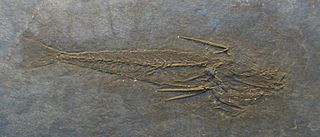
Acanthopleurus is an extinct genus of marine triplespine that lived in the seas over what is now Europe during the early Oligocene epoch.
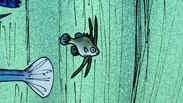
Cretatriacanthus is an extinct genus of prehistoric marine ray-finned fish from the Late Cretaceous. It contains a single species, C. guidottii from the late Campanian or early Maastrichtian of Nardò, Italy. It is generally placed as a basal tetraodontiform, although more recent studies have disputed this, finding it to instead represent an early basal percomorph.

Pseudotriacanthus is a monospecific genus of marine ray-finned fish belonging to the family Triacanthidae, the triplespines or tripodfishes. The only species in this genus is Pseudotriacanthus strigilifer, the longspined tripodfish. This taxon is found in the Indo-West Pacific region.
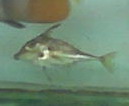
Tripodichthys is a genus of marine ray-finned fish belonging to the family Triacanthidae, the triplespines or tripodfishes. The three species in this genus are found in the Indian Ocean and the western Pacific Ocean in shallow water over soft substrates.
Trixiphichthys, is a monospecific genus of marine ray-finned fish belonging to the family Triacanthidae, the triplespines or tripodfishes. The only species in this genus is Trixiphichthys weberi, the blacktip tripodfish or longnosed tripodfish. This taxon is found in the Indo-West Pacific region.
Mephisto fraserbrunneri, the devil's spikefish, is a species of marine ray-finned fish belonging to the family Triacanthodidae, the spikefishes. This species is found in the Indian Ocean.

Parahollardia is a genus of marine ray-finned fishes belonging to the family Triacanthodidae, the spikefishes. These demersal fishes are found in the Western Atlantic Ocean.

Triacanthodes is a genus of marine ray-finned fishes belonging to the family Triacanthodidae, the spikefishes. These fishes are found found in the Indian and Pacific Oceans.

Triacanthus biaculeatus, also known as the short-nosed tripod fish, black-finned triple-spine, blacktail tripodfish, hollow-snouted tripodfish or silver tripodfish, is a species of marine ray-finned fish belonging to the family Triacanthidae, the triplespines or tripodfishes. This species is found in the Indo-West Pacific region.

Percomorpha is a large clade of ray-finned fish with more than 17 000 known species that includes the tuna, seahorses, gobies, cichlids, flatfish, wrasse, perches, anglerfish, and pufferfish.

Paratriacanthodes retrospinis, the sawspine spikefish, is a species of marine ray-finned fish belonging to the family Triacanthodidae, the spikefishes. This species is found in the Indo-Pacific region.

Triacanthus nieuhofii, the silver tripodfish, is a species of marine ray-finned fish belonging to the family Triacanthidae, the triplespines or tripodfishes. This species is found in the Indo-West Pacific region.
Plectocretacicoidei is an extinct suborder of Actinopterygii belonging to the order Tetraodontiformes, which includes the triggerfishes, filefishes, pufferfishes and related groups.

Hollardiinae is a subfamily of marine ray-finned fishes belonging to the family Triacanthodidae, the spikefishes. This small subfamily comprises two genera and a total of five species and all, except one species, are found in the tropical and subtropical waters of the Western Atlantic Ocean. The exception is found in the western and central Pacific Ocean.

Balistoidei, or Sclerodermi, is a suborder of ray-finned fishes belonging to the order Tetraodontiformes, the order which includes the pufferfishes, ocean sunfishes, boxfishes and related fishes. This suborder comprises two extant and three extinct families, the extant species in this taxon are widespread throughout the tropical and temperate seas of the world.













